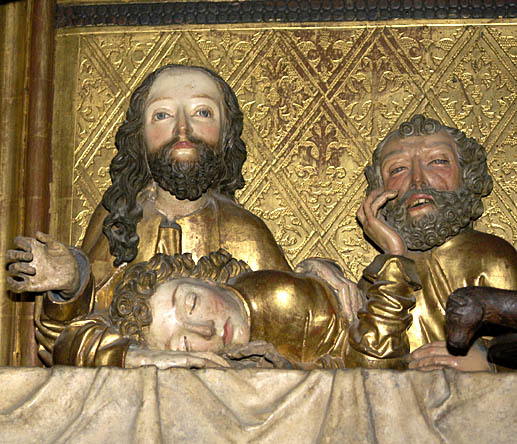Slovakia – Košice, Prešov September 30, 2019
POPRAD
LEVOČA
SPIŠSKÝ HRAD and the ASSOCIATED CULTURAL MONUMENTS World Heritage Site
St. James’ Church. Part of the WHS (2009), it is the 2nd largest church in Slovakia at 49.5m long, 22m wide, nave height 19m. Built in the 14th century, it has 3 naves with the chapels, vestibules and galleries added later. The medieval symbolism of numbers is: 3 naves = Holy Trinity, 12 pillars = 12 apostles, originally 5 entrances = 5 wounds of Jesus.
The main altar is the highest late-Gothic wooden wing altar in the world at 18.62m high and 6.27m wide carved in 1508-10, gilt in 1517. There are 14 altars, each to a saint. The other highlights are the 1626 pulpit showing the genesis of Christianity, 1630 organ, 1390 murals, and the Chapel of Baptism with a 14th century font. €3
The church was being renovated but buy a ticket for entrance on the half hour. Guided tours only for groups of 10 or more, not in English. There is a very good printed guide to all the great sites in this church.
Spišský Hrad, Next to the church this 3-story building (supposedly a castle) has double arcades on the north and a local handicraft/antique store and coffee shop on the bottom. The top two floors are a museum with a very nice large Gothic room and the history of Levoca. €5, 4 reduced
Dom Majstra Pavla. This small museum, also on the main square, showcases Master Paul, the famous sculptor, who in the early 1500s made most of the altars in this church and the one in Banska Bystrica, all masterpieces. 5, 4 reduced
SPIŠ
St. Martin’s Cathedral (Spišská Kapitula). This church has many magnificent altars festooned with wonderful paintings (of many saints). Visited by guided tour on the hour.
€2.50
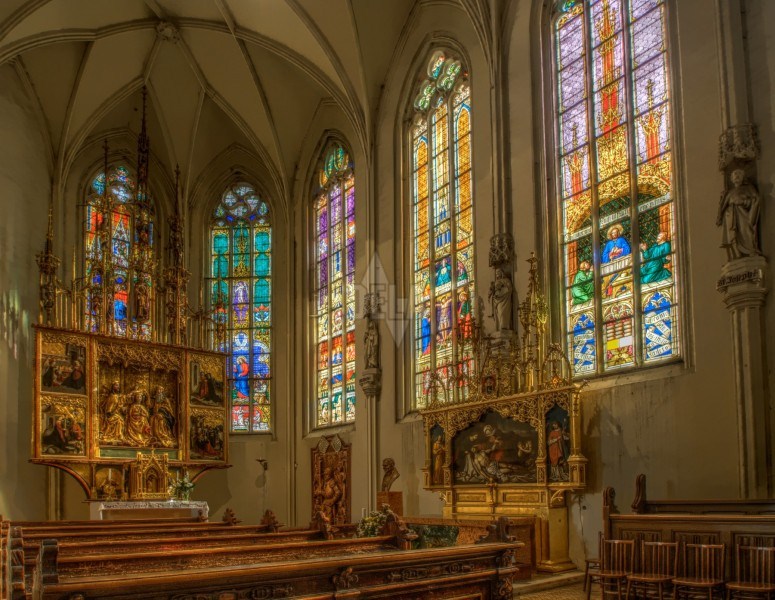
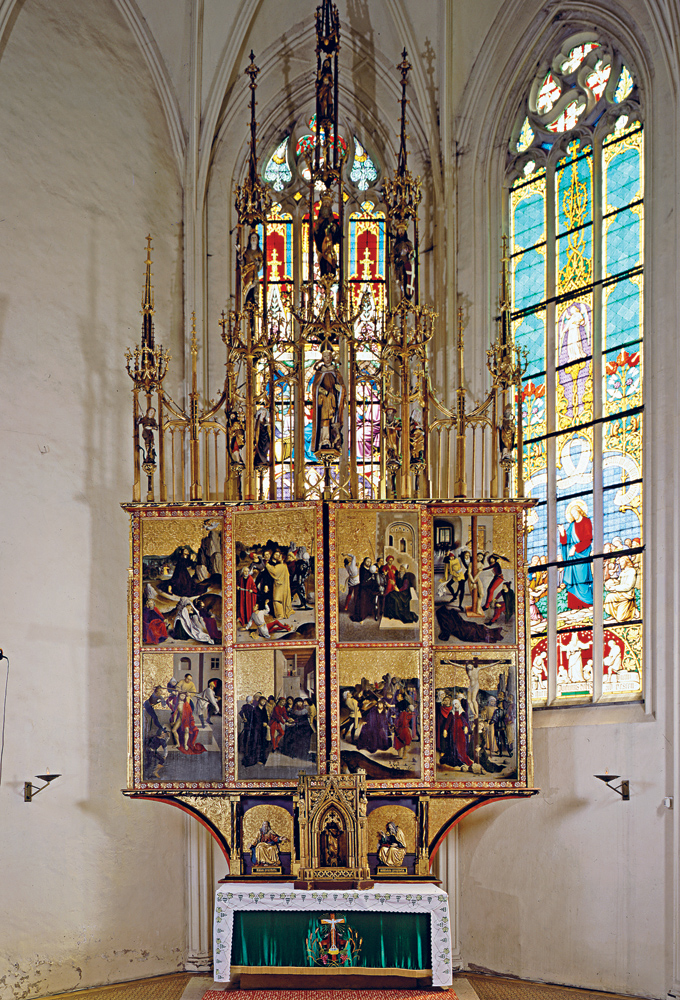
The Calvary of Jerusalem (Spix Jerusalem) is a series of four chapels and 7 shrines, a model of ancient Jerusalem, beside the church (presently under reconstruction) and dating from 1646-1773.
Spiš Castle. This castle ruins sits on the mountain just east of the town. Bastions cascade down the south side of the mountain.
PREŠOV
Observatory and Planetarium. In a beautiful building, there are no exhibits. They have one show in English. Normally viewings are for groups of 10 or more. €20
WOODEN CHURCHES OF THE SLOVAK CARPATHIANS
A UNESCO World Heritage Site that consists of nine wooden religious buildings constructed between the 16th and 18th centuries in eight different locations in Slovakia. They include two Roman Catholic (Hervartov, Tvrdošín), three Protestant (so-called Articular churches in Hronsek, Leštiny, Kežmarok) and three Greek Catholic churches (Bodružal, Ruská Bystrá, Ladomirová) plus one belfry in Hronsek. In addition to these churches there are about 50 more wooden churches in the territory of present-day Slovakia mainly in the northern and eastern part of the Prešov Region.
Roman Catholic Churches
Church of Saint-Francis Assisi, Hervatov 15th.. This church has a Gothic character as represented by its tall but narrow structure unusual for a wooden church. It was built in the second half of the 15th century, the oldest one in Slovakia. The stone floor is unusual too as most have wood floors (the stones are covered with a wood plank floor but the underneath is stone). Covering all the walls are wall paintings, added in 1665 during the reformation period and they depict, among others, Adam and Eve in the Eden or the struggle of St. George with the dragon. The main altar of Virgin Mary, St. Catherine of Alexandria, and St. Barbara was made between 1460 and 1470 and restored in the second half of the 20th century. There are more altars with great polychromes.
It is a small brown-painted log church with a large belfry. There are only 2 windows in the nave and two in the apse. The church dates from the later 15th century and the paintings in the apse are original. The 1565 paintings on the one wall are Adam and Eve, St George and on the bottom a parable about Jesus (the groom) and 10 Polish virgins, 5 with lamp oil and 5 without – that we should prepared for Jesus’ second coming. Connected to the church, the belfry has 2 bells from 1921 and 1934. Another small bell from 1753 sits in the little tower and rings during mass. The other special thing is the wood baptismal font – very cute.
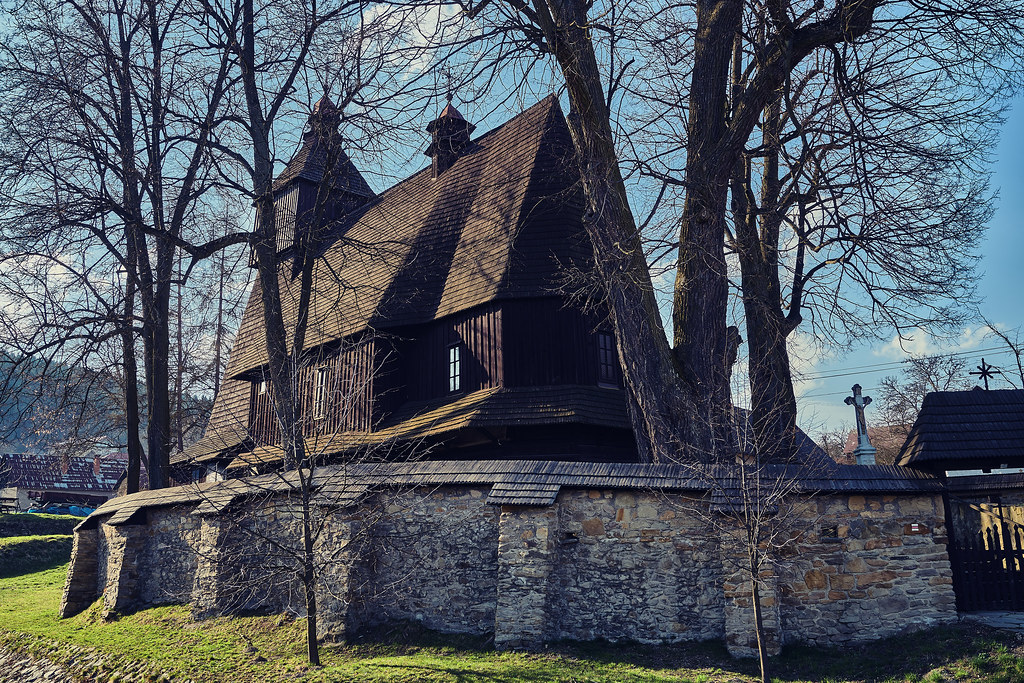
I drove north from Presov about 45kms to see this church on my way to Bardejov. It was closed (as they usually are) but it had a sign on the door with hours (8:30-17:30 M-F, 9:00-17:00 Saturday and after 13:30 on Sundays) and 2 phone numbers. Jan didn’t answer his phone but Anna Mackanivova (+421 918 678260) did and arrived in 15 minutes. Anna (in her 40s) was very helpful and spoke great English and told me much history. She was very proud of her church. €2
Church of All Saints, Tvrdošin 15th. This Gothic church was built in the second half of the 15th century and modified in a Renaissance style in the 17th century. Baroque main altar depicting All Saints is from the end of the 17th century. Remaining part of the original Gothic altar with St. Peter and St. John the Baptist ended up in muzeum in Budapest after the World War I. Worth of notice are also ceiling paintings depicting the starry heaven, as well as many religious artefacts from the 17th century.
Protestant Churches
Wooden Articular Church in Kežmarok 1721.
Built in 1717, church in Kežmarok with one of the most fascinating interiors with exceptional wall paintings as well as wood carvings is considered to be the most beautiful of the last 5 remaining articular churches in Slovakia. In order to raise money for the construction of the church, fund-raising campaigns were conducted in many parts of Europe, e.g. Sweden and Denmark. The architect of the church was Juraj Müttermann from Poprad and with its width of 30.31m, length of 34.68m, and height of 20.60m, it together with 6 side choirs it can serve more than 1500 worshipers, which is quite an achievement for a wooden church. Ceiling paintings started in 1717 and continued for several decades. They depict blue heaven, 12 apostles, 4 evangelists, plus the Holy Trinity above the altar. Ján Lerch from Kežmarok made the altar between 1718 and 1727 with the central motive of the Calvary. Extraordinary masterwork is also the organ built between 1717 and 1720 by Vavrinec Čajkovský, and extended in 1729 by Master Martin Korabinský from Spišská Nová Ves. After general restoration in the 1990s services are again regularly hold there.
Wooden Articular Chruch, Leštiny 1688. Construction of the wooden evangelical articular church in Leštiny in the Orava region of Slovakia was ordered by Jób Zmeškal and finished in 1688. Interior dates back to the 17th and 18th century and it is whole beautifully painted. Main altar is from the 18th century and the famous Slovak poet Pavol Országh Hviezdoslav was baptised here as well.
Church of Saint-Nicolas, Bodružal 1658. Greek Catholic church of St. Nicholas in Bodružal built in 1658 consists of three interconnected square-shaped parts along the east–west axis with 3 towers (the biggest one with the bells) topped with little onion domes and iron crosses. Artistically it belongs to folk Baroque style. Church is surrounded with the cemetery, wall, and the belfry from the 19th century. Some of the 18th century wall paintings are still preserved as well as iconostasis, and other icons from the same century. Altar was reconstructed in 1990s and the whole building subsequently in the 2004. Two of the three bells was melted down in the World War I and replaced only in the second half of the 1920s. From 1968 until the middle of the 1990s the church was biritual, i.e. holding Greek Catholic as well as Eastern Orthodox services. nowadays it belongs only to the Greek Catholic Church.
Church of Saint Michael the Archangel, Ladomirová 1742
Church of Saint Nicolas, Ruská Bystrá 18th century. Built at the beginning of the 18th century has just 2 towers and the shape of its almost perfect geometric roof resembles traditional houses of peasants. Interior with religious artefacts dates back to the 18th century as well. Church of Archangel Michael in Ladomirová built in 1742 without a single nail has basically the same design as the one in Bodružal including its surroundings (wall, cemetery, belfry).
I should have seen this when I was in Poland but it was still quite a drive.
Wooden Articular Church in Hronsek 1726. Severe restrictions embodied in the articles of the Congress of Sopron (1681) that enabled building of Protestant, so called articular, churches caused their extraordinary appearance. They must have been built within the single year, without any metal parts such as nails, and without any tower. Thus the construction of the church in Hronsek began on 23 October 1725 and was finished in the autumn of the 1726, the same year when the adjacent belfry was built as well. Church is 8m high and has a shape of the cross with arms 23 and 18m long. As there are many unusual motives from Scandinavian architecture, it is assumed that craftsmen from Norway and/or Sweden participated on the construction site. Unique is also the ordering of the benches on the choirs so that the church can accommodate 1100 worshipers through its 5 doors. The altar has 6 tables from 1771 by Master Samuel Kialovič.
Belfry, Hronsek.
BARDEJOV (pop 35,000)
This town in NE Slovakia sits on the floodplain terrace of the Topla River in the hills of the Beskyd Mountains. Its town center is completely intact.
History. First mentioned in the 1240s when the monks complained to King Bela IV about Presov violating its borders. St Giles church had already been built. It was heavily fortified in the 14th century and a center of trade with Poland with 80 guilds controlling the flourishing economy. Its golden age ended in the 16th century with wars, pandemics and other disasters.
In the first part of the 18th century, things improved when Slovaks and Hassidic Jews came regaining its old population. The burgher’s houses were rebuilt. A Jewish quarter with a synagogue, slaughterhouse and ritual baths developed plus churches and bridges were built. It continued to thrive with an 1893 railway and industry. After union with Czechoslovakia in 1918, it became a backward farming region, it worsened during WW II and was taken by Soviet troops in Jan 1945. Before the war Jews made up 34% of the town population. 3,000 were deported to concentration camps and most murdered. None live here now. After 1950, much was restored.
Bardejov Town Conservation Reserve. A World Heritage Sites, it is most known for its authentic town square with preserved Medieval, Renaissance and Gothic architecture. After 20016, the Jewish properties have been restored. The 1505 town hall in the center of the square is Gothic in its lower part and the upper Renaissance and is now the museum.
The fortification system and town wall date fro the 14th and 15th centuries.
Saris Museum. In the town hall in the center of the long square, it tells the history of the town.
Church of St Egidius (St Giles). A 3 nave basilica with multiple chapels, it was built between 1247-1464. It has 11 precious Gothic winged altars with panel paintings. The pews were very decorated with wood balls, animals, spiral columns and decorative backs.
Something was happening in the church that I have never seen. The center aisle was full of people 3 wide waiting their turn to go to 4 priests in the chancel, kneel and speak – confession? There were all ages from little kids to a few older.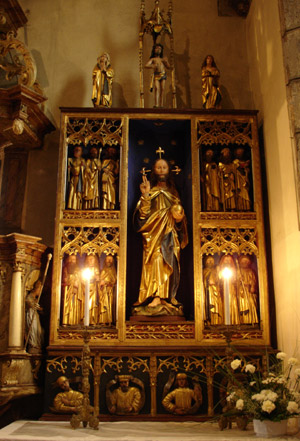
PRIMEVAL BEECH FORESTS of the CARPATHIANS (World Heritage List 2007). Thanks to this fact, the Carpathian primeval beech forests of Stužica, Rožok and Havešová in the Bukovskévrchy Mts. and Vihorlatský prales primeval forest in the Vihorlatskévrchy Mts. in CHKO Vihorlat are of world importance. The first three of them are situated in the area of the Poloniny National Park.
KOŠICE
THE CONCEPT of the LENTICULAR HISTORICAL TOWN CORE of KOŠICE CITY Tentative WHS (12/06/2002).
The central area of the city runs several blocks with the two streets enclosing the large central area. From south to north, this area has St Michael Chapel, St Elizabeth Cathedral, the large opera house, a 5-story square tower, a large fountain with lights at night and chintzy music blaring from speakers, and then the Plaque Column. Restaurants line each side.
Holy Trinity Church. A large single nave church with 4 large chapels on the sides. The baroque interior is all faux-stucco/marble, but the ceiling is quite wonderful with several murals. This church is on the east side of the square in the middle.
St. Elisabeth Cathedral. This Gothic cathedral is Slovakia’s largest church and one of the easternmost Gothic cathedrals in Europe. The record of the existence of Kassa (modern day Košice), dating from 1230, is connected with the existence of the rectory church. In the process of the settlement’s transformation from a rural community into a town, all its periods of successes and failures have been reflected in St Elisabeth’s Cathedral.
With a capacity of more than 5000 people, it is 60 metres long, 36 metres wide and the height of the north tower is 59 metres It has five naves, two towers and a unique layout where the central nave and four aisles are crossed in the middle by one transept of the same height and width as the central nave to create a Greek cross.
The complex of the cathedral and adjacent buildings – St Michael Chapel and Urban Tower were declared as Cultural Heritage Monuments in 1970.
St. Michael Chapel. This small Gothic chapel was erected in the first half of the 14th century as a cemetery chapel inside the town walls. The lower part of the chapel was initially an ossarium, the upper one served for offices for the deceased. The chapel served as a Slovak church whereas the Cathedral of Saint Elisabeth was a German and Hungarian church.
During the rebuilding in the years 1902–1904, they pulled down the northern aisle (it was erected in 1508) and bricked 17 old gravestones (from the 14th century until the 17th century) into the exterior walls of the chapel to save them from destruction. It had a complex reconstruction between 1998–2006.
The patron of the dead, Saint Michael the Archangel, trampling the Devil, is shown on the facade. The first municipal coat of arms in Europe dated to 1369 is above the door leading to the vestry.
Plague Column. The column is situated in a small park and commemorates the gratitude to Mary for an end to the plague epidemic from 1709 and 1710. It was erected at the place of medieval gallows at Main Street in 1723. Local legend holds that the relics of Saint Valentine are hidden beneath the structure.
It is a 14-metre-high column on a stone basement with sculptures of Saint Joseph, Saint Sebastian and Saint Ladislaus. There is a sculpture of the Virgin Mary on the top of the column. The sculptures of Saint Gabriel, Saint Elizabeth of Hungary, Saint Margaret, Saint Michael the Archangeland Saint Barbara are on the pillars of the fence.
Aupark. Just past the south end of the square, this is a large, popular shopping mall with all the usual stores and a good food area.
Herliansky Geyser near Kosice is a rare cold geyser at the foot of the Slanske vrchy, in the old spa area Herlany – Rankovce. It is active continuously since 1872. The eruption of the geyser causes carbon dioxide extending from the substrate along tectonic breaks and sprays up to a height of 7 to 15 meters with a period of 32 to 40 hours, the eruption takes about 25 minutes and then gradually loses to strength.
I wanted to go here but the periodicity of the geyser would make it a chance viewing. One would have to be either lucky or set up your tent and camp (then it would probably erupt when you are asleep!)
ORIGINAL MEADOW – PASTURE SITES of SLOVAKIA – Tentative WHS (11/02/2002)
This is a set of sites in Slovakia with traditional economic activities dependent on the local natural conditions. There are three subcategories: viniculture, grassland and old mining. The impact of natural-climatic and social conditions on the population’s development in housing and farming is demonstrated. Several criteria were used: shape, size, compactness, anthropogenic forms of relief, preservation of traditional farming, buildings and historical forming the cultural landscape.
Vinicultural areas: Skalicki, Podmalokarpotsk;a, Modmkamenskd and Tokajska. Tokajskd Anicultural
Grassland areas were selected using criteria: a low degree of Intensification, a high landscape diversity, well preserved traditional wooden and other original dwellings, preserved traditional forms of farming, significant social and ecological value of the territory, harmonisation of agricultural functions, forest and water management recreation and nature protection with landscape-ecological values of the area: Kostoliansko-Iehotsky region (Jedlové Kostol’any – Malá Lehota and Vel’ká Lehota), Horehronie (Hel’pa – Telgart), Bocianska valley (Vysna Boca and Nizna Boca), Turiec (Sklabina – Bela – Blatnica), Podpolianska area (Strelniky – Poniky – Hrochot – Hrinova – Ocova), Orava (Podbiel – Zuberec – Zazriva – Terchová), Zamagurie (Zdiar – Osturna – Velka Frankova – Mala Frankova – Jezersko), Liptovska Teplicka and Jakubany.
Old mining landscape areas: Criteria: shape and size, compactness, anthropogenic forms of relief, presence of constructive technical and secret objects, historical conditions of cultural landscape formation, general contextualisation into cultural landscape and relations to currently requested functions (tourism). mining level, sacral and technical monuments and historical centers Banská Stiavnica region (silver – Banská Stiavnica – Hodrusa – Stiavnické Bane – Banská Belá). Kremnica region (gold – Kremnica – Tajov – Banská Bystrica – Spania Dolina) and Cervenica (opal – Cervenica – Zlatá Baña).
Tokaj Wine Region is a wine-growing region located in south-eastern Slovakia and north-eastern Hungary. The two vine-growing areas were once part of greater Tokaj wine region of the Kingdom of Hungary. Due to the Treaty of Trianon a smaller part (3 villages and about 175 hectares of vineyards) became part of Czechoslovakia (today Slovakia). The majority of the region (around 28 communities and some 5,500 hectares of vineyards) remained part of Hungary. Nowadays, the Slovak part of Tokaj wine region comprises 7 communities and approximately 908 hectares of vineyards. It is a tentative WHS (06/02/2002).
Observation Tower is a 12-metre high observation tower with an interesting shape. It resembles a wooden barrel and is situated directly in the vineyards between the villages of Malá Tŕňa and Černochov.
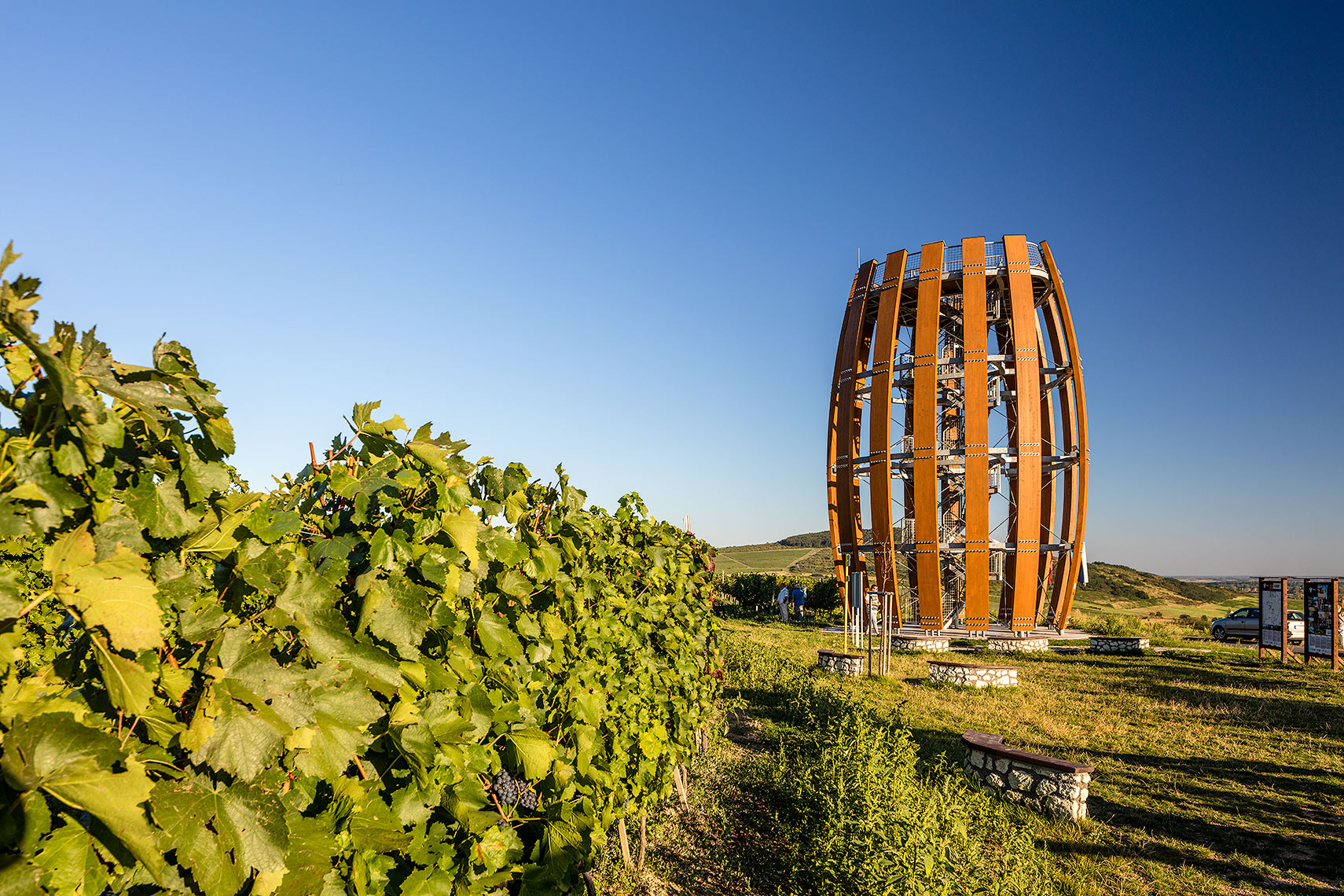
I entered Hungary from here, saw the northeast section and then returned to southeast Slovakia to see the karst areas.
KARST VALLYS of SLOVAKIA
Karst valleys have many specific features that distinguish them from other areas especially the interaction of natural factors – geological base (limestone), relief, water, soil, climate, vegetation and fauna. On more than 360 square kilometers, the Slovak Karst forms one of the most beautiful regions of Slovakia. It is located in the district of Roznava, Gelnica and surrounding Kosice. The Drienovska, Gombasecka and Jasovska caves are here.
Slovenský karst. Situated in the south of Slovakia on the border with Hungary, it is the largest karstic area in the center of Europe. It consists of 1110 caves and abysses. In 1995 the bilateral Slovak-Hungarian project with the title Caves of the Slovak and Aggtelek Karst was included in the UNESCO WHS list.. In 2000 this inscription also included the ice cave of Dobšinská ľadová jaskyňa, one of the largest of its kind in Europe.
In 2007 the Carpathian primeval beech forests of the Bukovské vrchy and Vihorlatské vrchy Mts. in the east of Slovakia were added to this list.
CAVES of AGGTELEK KARST and SLOVAK KARST
This is a UNESCO World Heritage site consisting of 712 caves spread out over a total area of 55,800 ha (138,000 acres) along the border of Hungary and Slovakia. This UNESCO World Heritage site includes seven components. They are Aggtelek National Park, Szendrő-Rudabánya Hill, and Esztramos Hill in Hungary, and Dobšinská Ice Cave, Koniar plateau, Plešivec plateau, and neighbourhood of Silica and Jasov in Slovakia.
Caves included are:
Baradla-Domica Cave complex is 21 km (13 mi) long with approximately one fourth of that on the Slovak side and the rest in the Hungary. The part that is visited is in Hungary.
Gombasek Cave was discovered in 1951 with 530 out of its 1,525 m (5,003 ft) opened to the public from 1955. The cave is also experimentally used for “speleotherapy” as a sanatorium, focused on airway diseases thanks to constant temperature of 9 °C (48 °F), high humidity of 98% and favorable microclimate. Geomorphologically it is one of the youngest but nevertheless also one of the most impressive caves in Slovakia with extraordinary decoration that gave it the nickname “Fairy tale cave”.
Dobšiná Ice Cave was added to the list of components of this World Heritage Site only in the year 2000. The cave was discovered in 1870 by Eugen Ruffinyi, though the entrance was known long before. Being open to the public just one year after its discovery, in 1887 it became the first electrically lit cave in Europe. Approximately one third of its 1,483m length is open from May to September. Thickness of the ice on the floor approaches 25m, with a surface area of 11,200 m2 and estimated volume of 145,000 m3 of ice. Average temperature is −1 °C (30 °F) and relative humidity between 96 and 99%. This cave is among the most beautiful and the most richly decorated ice caves in the world.
Ochtinská Aragonite Cave is just 300 m (980 ft) long with a tourist circuit not longer than 230 m (750 ft), it is famous for its rare aragonite filling since there are only three aragonite caves discovered in the world so far. In the so-called Milky Way Hall, the main attraction of the cave, white branches and clusters of aragonite shine like stars in the Milky Way. The cave was discovered in 1954 and opened to the public in 1972. Temperature in the cave is around 7 °C (45 °F) with relative humidity between 92 and 97%.
Jasovská Cave was partly opened for the public in 1846, making it the oldest publicly accessible cave in Slovakia. The lower parts of the cave were discovered in 1922 to 1924. More than one third of its 2,148 m (7,047 ft) total length is open to the public. Paleolithic and Neolithic archeological artifacts were found in the cave together with those of Hallstatt Culture.
NOMAD MANIA Slovakia – Košice, Prešov October 2-3, 2019
World Heritage Sites
Bardejov Town Conservation Reserve
Caves of Aggtelek Karst and Slovak Karst
Levoča, Spišský Hrad and the Associated Cultural Monuments
Primeval Beech Forests of the Carpathians and the Ancient Beech Forests of Germany
Wooden Churches of the Slovak part of the Carpathian Mountain Area
Tentative WHS
Fungal Flora of Bukovské Hills (12/06/2002)
Geyser in Herlany (12/06/2002)
Karst Valleys of Slovakia (12/06/2002)
Natural Reserves of Tatras Mountain (12/06/2002)
Original Meadow – Pasture Sites of Slovakia (11/02/2002)
The concept of the lenticular historical town core of Košice City (12/06/2002)
Tokaj Wine Region (06/02/2002)
Sights (Temporarily Reinstated)
Botanic garden on Lomnický Peak
Ochtinská Aragonite Cave
Red Monastery and Pieniny National Park
Slovensky Raj National Park
Spiš Castle
Borders
Hungary-Slovakia
Poland-Slovakia
Slovakia-Ukraine
XL
Slovak Tokaj Wine Region
Veľké Slemence/Mali Selmentsi
Railway, Metro, Funiculars, Cable Cars
Lanovka na Skalnaté pleso
Slovakia Intercity Railway Experience
Starý Smokovec to Hrebienok Funicular
Tatranská Štrba and Štrbské Pleso Cog Railway
Museums:
Medzilaborce: Andy Warhol Museum of Modern Art
Vysoke Tatry: Ski Museum
Castles, Palaces, Forts:
Betliar: Betliar Mansion
Humenné: Humenné Mansion
Krásnohorské Podhradie: Krásna Hôrka Castle
Stará Ľubovňa: Stará Ľubovňa Castle
Žehra: Spiš Castle
Religious Temples:
Červený Kláštor: Červený Kláštor Monastery
Spišská Kapitula: St. Martin’s Cathedral
World of Nature
Pieniny
Poloniny
Slovak Karst
Slovak Paradise
Botanical Gardens: Vysoké Tatry: Botanic garden on Lomnický Peak
Waterfalls
Giant Waterfall
Kmeťov
Caves
Belianska Cave
Dobšinská Ice Cave
Gombasek Cave
Jasovská Cave
Ochtinská Aragonite Cave
Open-Air Museums
Humenne: Open-air Museum
Stará Ľubovňa Open Air Museum
The Dark Side: Dukla Pass
European Cities
KOŠICE World Cities and Popular Towns
Tentative WHS: The concept of the lenticular historical town core of Košice City (12/06/2002)
Airports: Košice (KSC)
Railway, Metro, Funiculars, Cable Cars: Košice Trams
Museums:
East Slovak Gallery
East Slovak Museum
Slovak Technical Museum
House Museums/Plantations: Memorial House of Francis II. Rákocziho
Religious Temples:
Holy Trinity Church
St. Elisabeth Cathedral
St. Michael Chapel
Festivals
Art Film Fest
Košice Music Spring Festival
Zoo: Košice Zoo
Botanical Gardens: Botanical garden of University of P. J. Šafárik
Malls/Department Stores: Aupark
Monuments: Plague Column
Aviation Museums: Museum of Aviation
POPRAD
Museums: Tatra Museum
PREŠOV
Museums: Prešov Regional Museum
Villages and Small Towns
KEŽMAROK
OSTURŇA
ŽDIAR
BARDEJOV
World Heritage Sites: Bardejov Town Conservation Reserve
Museums: Saris Museum
Religious Temples: Church of St Egidius
LEVOČA
World Heritage Sites: Levoča, Spišský Hrad and the Associated Cultural Monuments
Museums: Dom Majstra Pavla
Religious Temples: St. James’ Church
ROŽŇAVA
Religious Temples: Rožňava Cathedral
